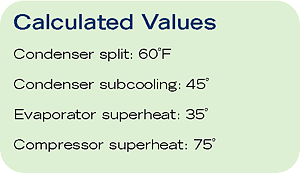When a restriction occurs before the receiver in a low-temp commercial refrigeration system, the evaporator and compressor will be starved. Any refrigerant that does enter the condenser will be trapped there, causing high condenser subcooling.
This high subcooling will take up valuable condenser surface volume, causing the condensing (head) pressure to elevate.
System And Symptoms
The system we’re going to examine in this article has a thermostatic expansion valve metering device with a receiver. The refrigerant is R-134a.
Table 1 shows a system checklist for a restricted liquid line before the receiver. Table 2 shows the calculated superheat, subcooling, and condenser split values.


High Discharge Temperature
High discharge pressures result from high compression ratios. High compressor ratios result from the elevated condensing temperatures. High condensing temperatures result from the liquid backed up in the condenser from the restriction between the condenser and the receiver.
High Condensing (Head) Pressure
High head pressures result from the liquid being backed up in the condenser, causing a reduced condensing surface area. The restriction before the receiver causes most of the liquid to remain in the condenser, and slowly get into the receiver.
This is far different than if the restriction was after the receiver. A restriction after the receiver would cause most of the refrigerant to be in the receiver. This would result in low head pressures because the receiver is designed to carry all of the refrigerant, plus a 25 percent refrigerant vapor head for safety purposes.
High Condenser Subcooling
With the restriction in the liquid line between the receiver and condenser, liquid will primarily remain in the condenser and cause high condenser subcooling.
Do not confuse this with an overcharge of refrigerant. An overcharged system will not have low evaporator pressures and high superheats. (For more information on system overcharge, please refer to “The Symptoms Of Refrigerant Overcharge,” Sept. 1, 2003.)
High Condenser Splits
Elevated condensing pressures and temperatures will cause the temperature difference between the surrounding ambient and the condensing temperature to increase. This temperature difference is called the condenser split.
Low Evaporator Pressures
Because of the restriction in the liquid line, the receiver, TXV, and evaporator will be starved. The compressor will keep pumping, trying to get vapors from the evaporator. This will draw the evaporator into a low pressure. How low the suction pressure gets will depend on the severity of the restriction.
Low Amp Draw
Amp draws will usually be low in this situation because the compressor is starved of refrigerant. Also, the low density of the small amount of refrigerant vapors coming into the compressor will cause low amp draws.
Bubbly Sight Glass
The sight glass will have bubbles because of the starved receiver, as well as the liquid line after the receiver. Depending on the severity of the restriction, the slight glass may have very little refrigerant running through it and look empty.
Short Cycling On LPC
Because the compressor is starved of refrigerant, the low-pressure control (LPC) will cycle the compressor off and on from the low (evaporator) suction pressures.
John Tomczyk is a professor of HVAC at Ferris State University, Big Rapids, Mich., and the author of Troubleshooting and Servicing Modern Air Conditioning & Refrigeration Systems, published by ESCO Press. Tomczyk can be reached at tomczykj@tucker-usa.com.
Publication date: 10/06/2003

Report Abusive Comment